When my spouse came home from a hike to Len Foote Inn gushing with excitement over the photographs a fellow backpacker had shared about the Grant Teton National Park, it took no encouragement to convince me to revisit one of the places I had seen as a teen. The next few posts will chronicle our backpacking trip and then I’ll tell you how to backpack the Grand Teton on a real budget. Lets begin at the Granite Canyon Trailhead.
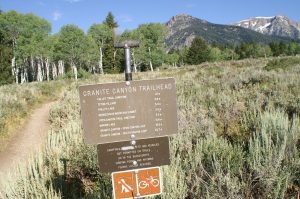
In the backcountry we didn’t see a lot of people, but many of the backpackers and trail runners we encountered were starting at the top of the Tram in Teton Village. We thought we’d get better acclimated to the altitude, which varied during our trek from about 6500 to 10400 feet above sea level, by walking up the Granite Canyon Trail past Marion Lake to the Death Canyon Shelf. It was a great decision because the Granite Canyon Trail should not be missed when wild flowers are in bloom.
The trailhead is inside the Grand Teton National Park, about three miles north of Teton Village on the Wilson-Moose road. Because we didn’t want to pay to leave a rental car sitting at the trailhead and because we weren’t making a loop, we hired OLD WEST Transportation in Jackson to take us to the trailhead.
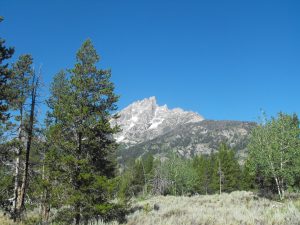
Initially, the trail starts off toward Granite Canyon by passing through a sagebrush meadow with a number of birch trees along the way, however Granite Canyon Trail has many personalities.
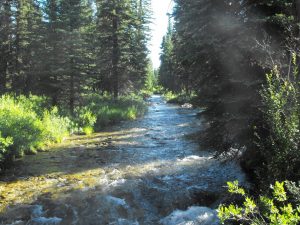
Before too long we cross a small bridge over Granite Creek which flows through the canyon. As you might expect, Granite Canyon Trail somewhat parallels the creek but doesn’t follow the bank of the creek. Once into Granite Canyon, you soon come to one of three camping zones designated by the Park Service. As with all the backcountry controlled by the National Park Service, you will need to get a permit for overnight camping. The first is the Lower Granite Canyon Zone and runs for about three and one half miles along the canyon. In this zone, the designated camping sites are numbered with small signs adjacent the trail and short side trails leading to the individual campsites and the one group campsite. The campsites are well spread out and there is no problem with neighbors being too close.
We shortly begin our acclimation to the altitude and the weight of our backpacks. This was an unsupported trip, so we had everything we needed for five days on the trail on our backs. Our acclimation began as the trail began to rise and change.
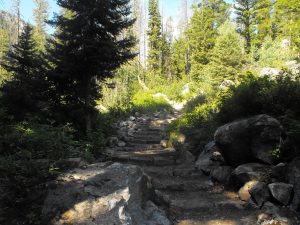
The birches faded away and the trail side became more forested with evergreens. We were expecting to gain 2000 to 2500 feet in elevation on the way to our first campsite and we weren’t disappointed. The well used trail had improvements like the set of steps we encountered as the trail began to rise and change. Did I mention bears? Apparently, the bears are quite active, so when we got our permits from the Jenny Lake Ranger Station, we were required to carry bear canisters, in which all of our food had to be stored. It took some reconfiguring of the backpacks to get these inside with the food in them.
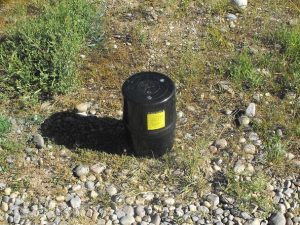
I mention that because as we got further from the trailhead, we realized that the possibility of bears was quite real. In addition to keeping the food in the canisters, we each were dutifully equipped with our bear strength pepper spray and one of us wore a bell, which we allowed to jingle when we were passing though heavy growth. Of course, Granite Canyon trail didn’t stay the same so the bell didn’t always ring.
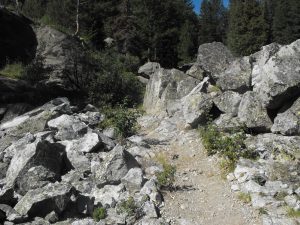
Just a little further down the trail, it veered away from the creek and took us through a boulder field. As always, we’re thankful for those who laid the trail out and cleared a path across these boulders to the next stretch of soil. That stretch of soil gave us our first real look at the wild flowers found along Granite Canyon trail.
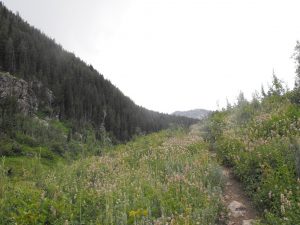
Our circuit took us past some amazing sights including some that took your breath away, but nowhere along our hike did we find wildflowers as gorgeous as we saw in the first two days. The yellow ones you can see in the picture above were dominant early in the hike but as you’ll see in our post on the Wildflowers of the Grand Teton, the colors along the trail matched the rainbow.
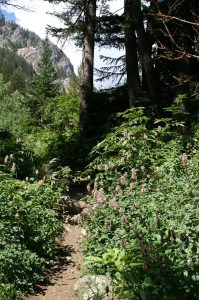
The yellow flowers gave way, temporarily to thicker brush with light lavender blossoms and the vegetation changed back from meadow to forest. Of course we are going ever higher in elevation and beginning to breathe a little heavier. One of the great rules of hiking is to always remember to look behind you and when we did, we realized why our breathing was a little labored even though the rise seemed gentle.
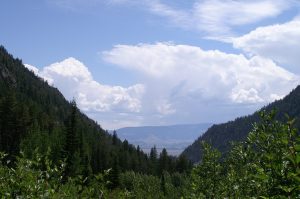
After just a couple of hours, looking back down the canyon toward the trailhead brought an instant smile from the fact that we had already gained so much in elevation. There was a lot more elevation to come, but at this point the joy of being on the trail in a beautiful setting made us think we’d risen to the clouds.
Toward the end of the day, we reached a divide in the trail with the left fork leading to the South Granite Canyon Camping Zone and the right leading to the Upper Granite Camping Zone. We took the fork to the right as our permit was for the Upper Granite zone. This zone is not as long and the sites are not designated by signage, except for the group site and the horse site, but rather are recognized by the recommended repeated usage of an older site to avoid creating numerous open areas for camping. The sites are easily identified as they are relatively near the trail and have clearly defined side trails leading to them.
We didn’t venture into the South Granite Canyon Camping Zone, however the trail through there leads to a trail to the top of Rendezvous Mountain and the Tram before rejoining the Upper Granite trail for the ascent to Marion Lake.
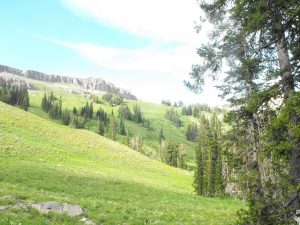
At the end of the Upper Granite Canyon camping zone, the trail comes to the meadow pictured above. The meadow was filled with the yellow flowers such that it changed color in the morning. We stopped at the last campsite in the zone, which was about 75 yards from the end of the zone and adjacent the creek. What we didn’t know that the three campsites at Marion Lake, which is about a mile further into the back country, sit on this side of the lake and are elevated by about 1000 feet looking out over the meadow. The next morning, we met a party that had hiked from the Tram to Marion Lake to spend the night and was headed out down Granite Canyon Trail. They told us that they had been amused by watching us scurrying about in the meadow, setting up our camp and what not.

We were not phased by their comments and agreed that we had just been happy to reach the campsite after about seven and one half miles of backpacking uphill along the beautiful Granite Canyon Trail.
Our next section of the trail takes us past Marion Lake onto the Death Canyon Shelf.

One thought on “Grand Teton Backpacking on the Granite Canyon Trail”